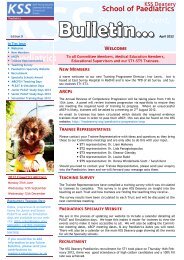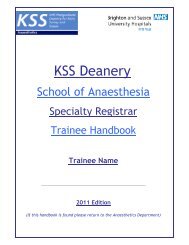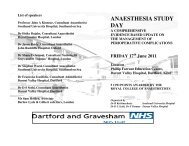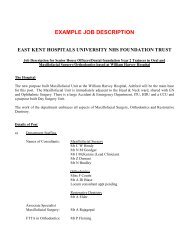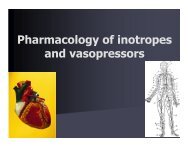BODY FLUIDS AND COMPARTMENTS FLUIDS - KSS Deanery
BODY FLUIDS AND COMPARTMENTS FLUIDS - KSS Deanery
BODY FLUIDS AND COMPARTMENTS FLUIDS - KSS Deanery
- No tags were found...
You also want an ePaper? Increase the reach of your titles
YUMPU automatically turns print PDFs into web optimized ePapers that Google loves.
<strong>BODY</strong> <strong>FLUIDS</strong> <strong>AND</strong><strong>COMPARTMENTS</strong><strong>FLUIDS</strong>Mark HarperConsultant AnaesthetistBSMS
<strong>BODY</strong> <strong>FLUIDS</strong> <strong>AND</strong><strong>COMPARTMENTS</strong><strong>FLUIDS</strong>Mark HarperConsultant AnaesthetistBSMSwith special thanks to Peter Gosling
<strong>BODY</strong> <strong>FLUIDS</strong> <strong>AND</strong> <strong>COMPARTMENTS</strong> A few basic principles Fluid compartments Fluids Fluids and fluid compartments Clinical use and abuse of fluids It’s not as simple as that Key papers and guidelines Some more basic principles by way of a summary mmm…beer
<strong>BODY</strong> <strong>FLUIDS</strong> <strong>AND</strong> <strong>COMPARTMENTS</strong> The most commonly described model is one withthree compartments: the vascular, (approximately 3 Lin adults), the interstitial (12 L) and the intracellular(25L). Blood cells and large molecular weight proteins areretained in the vascular compartment by the vascularendothelium, but Water, electrolytes and small molecules such asglucose pass freely from the vascular compartmentto the interstitial compartment.
<strong>BODY</strong> <strong>FLUIDS</strong> <strong>AND</strong> <strong>COMPARTMENTS</strong> The cell membrane of the cellular compartment hastwo energy consuming pumps which actively excludesodium from the cell and retain potassium within thecell. So large molecules will tend to remain in the vascularspace, sodium will equilibrate across the vascularand interstitial compartments and only water canmove across all three spaces.
<strong>BODY</strong> <strong>FLUIDS</strong> <strong>AND</strong> <strong>COMPARTMENTS</strong> The pharmacology of different intravenous fluidsdepends of the physiology of the fluid compartmentsof the body and how this changes in illness. In most conditions requiring intravenous fluidtherapy, the distribution of fluid between the threecompartments changes, depending on the nature ofthe illness.
<strong>BODY</strong> <strong>FLUIDS</strong> <strong>AND</strong> <strong>COMPARTMENTS</strong> Inflammation: the vascular endothelium allowspassage of larger molecules with their attendant fluidto pass into the interstitial space. Intracellular energy deficit: compromises the actionof the membrane sodium potassium pumps ->movement of sodium into the cell and potassium outof the cell
ASSESSMENT– History– Thirst– skin turgor– Mucosa– Oedema– CVS– JVP– Urine output– CVP– Dynamic CVS monitoring– PAC/PCWP<strong>FLUIDS</strong>
<strong>FLUIDS</strong> REQUIREMENTS– NORMAL• fluids• electrolytes– ABNORMAL• pre-op fasting• evaporation• bleeding• GIT/fistulaeInput:• 1500 liquid• 750ml food• 250ml metabolismOutput:• 1800ml urine• 100ml faeces• 600ml insensible
Body compositionPLASMA INTERSTITIAL INTRACELLULARNa+ 140 140 10K+ 4 4 150Cl- 110 110 3Mg++ 3 3 30
<strong>FLUIDS</strong>Normal 24 hr fluid and electrolyte balanceInputOutputWater 2500 mL 2500ml (1800ml urine)Sodium 100 mmol 100 mmolNitrogen 500 mmol 500 mmolOther 100 mmol 100 mmolTotal 800 mosmols 800 mosmolsUrine osmolality 800/1800 = 450 mosm/LUrine 40% maximally concentrated
<strong>FLUIDS</strong> CRYSTALLOIDS– REPLACEMENT– THERAPEUTIC COLLOIDS– GELATINS– DEXTRANS– STARCHES: 1st, 2nd, 3rd and 4th generation– BLOOD– BLOOD PRODUCTS– BLOOD SUBSTITUTES
Distribution of Infused SolutionsPlasmaInterstitial fluidIntracellular fluidColloids0.9% NaCl0% 20% 40% 60% 80% 100%5% Dextrose
<strong>FLUIDS</strong>CRYSTALLOIDSDefinition: crystalloids are salt solutions containingelectrolytes or easily metabolised small molecules suchas glucosePrimary Uses:1. To provide free water (glucose)2. To replace lost electrolytes (salt solutions)3. To provide a vehicle for i.v. delivery of drugs
<strong>FLUIDS</strong>CRYSTALLOIDSDefinition: crystalloids are salt solutions containingelectrolytes or easily metabolised small molecules suchas glucosePrimary Uses:1. Poor man’s volume expander (10-20% stays in vasc.space)2. An i.v. fluid for the unthinking e.g. ‘normal’ salinemust be safe
<strong>FLUIDS</strong> CRYSTALLOIDS– REPLACEMENT• saline• glucose• combinations• balanced salt solutions
<strong>BODY</strong> <strong>FLUIDS</strong> <strong>AND</strong> <strong>COMPARTMENTS</strong>Concerns about fluid and electrolyte prescribingHyponatraemia after orthopaedic surgery BMJ1999;318:1363-64‘Appropriateness of fluid regimes’Stoneman et al: Variability in post-operative fluid andelectrolyte prescription. Br J Clin Pract 1997;51:82-84‘Concern about variability in perioperative fluidadministration’Sherry et al: Extremes of age: The 1999 report of theNational Confidential Enquiry into PerioperativeDeaths 1999‘Fluid regimes highlighted’
<strong>BODY</strong> <strong>FLUIDS</strong> <strong>AND</strong> <strong>COMPARTMENTS</strong>Concerns about fluid and electrolyteprescribingHypernatraemia in the ICU: an indicator of quality ofcare?Poldermann et al. Crit Care Med 1999;27:1;105-8‘Hospital acquired hypernataemia versus admissionhypernatraemia was associated with higher mortalityrate’Changes in weight, fluid balance and serum albumin inpatients referred for nutritional supportLobo et al: Clin Nut 1999;18:197-201‘12L mean fluid overload in oedematous patientsreferred for nutritional support’
<strong>FLUIDS</strong> SALINE– Evans GH. The Abuse of Normal Salt Solution: AmericanMedical Association 1911.
<strong>FLUIDS</strong> SALINE–Evans GH. The Abuse of Normal Salt Solution: Journal of theAmerican Medical Association 1911.
Diet, Salt and EvolutionPrehistoric dietary sodium intake was lowHuman ability to conserve sodium is powerfulHuman ability excrete sodium is weak
Chemical and Physical Properties ofCrystalloidsFluidNormalplasmaSodiummmol/LChloridemmol/LPotassiummmol/L140 95 4 2950.9% saline 154 154 0 308Ringerslactate130 109 4 273Hartmanns 131 111 5 275Plasmalyte 140 98 5 2947.5% saline 1283 1283 0 2566Osmolaritymosm/L
<strong>FLUIDS</strong> SALINE– Evans GH. The Abuse of Normal Salt Solution:American Medical Association 1911.– Stewart PA. Modern quantitative acid-basechemistry. Can J Physiol Pharmacol. 1983;61:1444-61.
Strong Ion DifferenceThe Strong Ion Difference (SID) is the difference between the sums ofconcentrations of the strong cations and strong ions:[SID] = [Na + ] + [K + ] + [Ca 2+ ] + [Mg 2+ ] minus [Cl - ] + [Other Strong Anions]140 + 4 + 1 + 1 = 146 100 + 6 = 106With normal protein levels SID is about 40mmol/L.Base Excess = 0 mmol/L
<strong>FLUIDS</strong>Independent•Pa CO2•strong ions•weak acidsDependent•HCO3SID = [Na+K+Ca+Mg]-[Cl-lactate]Stewart PA. Modern quantitative acid-base chemistry.Can J Physiol Pharmacol. 1983;61:1444-61.
Strong Ion DifferenceThe Strong Ion Difference (SID) is the difference between the sums ofconcentrations of the strong cations and strong ions:[SID] = [Na + ] + [K + ] + [Ca 2+ ] + [Mg 2+ ] minus [Cl - ] + [Other Strong Anions]140 + 4 + 1 + 1 = 146 100 + 1 = 101Measured SID = 45 mmol/LBase Excess = + 5 mmol/L
Strong Ion Difference[SID] = [Na + ] + [K + ] + [Ca 2+ ] + [Mg 2+ ] minus [Cl - ] - [Other Strong Anions]140 + 4 + 1 + 1 = 146 120 + 6 = 126Hyperchloraemia SID now 26 mmol/L.Base Excess about – 5 to -10 mmol/LAnion Gap normal because chloride ions included in calculation
<strong>FLUIDS</strong>Effects of 2000 mL acute fluid loading in 10volunteers. Blind cross over trial(Lobo et al Br J Surg 2001)10 volunteers5 given 2L 0.9% saline 5 given 2L 5% dextrose2 week interval5 given 2L 5% dextrose5 given 2L 0.9% saline
Assume blood volume about 3000 mL0.08Hct x 3000 = 240mL240/2000 = 12% saline in vasc. space
<strong>FLUIDS</strong> Balanced vs. salineWilliams EL et al. The Effect of Intravenous Lactated Ringer’s Solution Versus 0.9% SodiumChloride Solution on Serum Osmolality in Human Volunteers. Anesthesia & Analgesia.1999;88(5):999-1003.
<strong>FLUIDS</strong>SALINE• Hyperchloraemic metabolic acidosis• Hyperosmolar states• Stimulation of ADH - fluid retention• Chloride causes renal vasoconstriction – fluid retention• Nausea, vomiting, abdo pain, hyperventilation, thirst• impaired cognitive ability, headachesHartmann AF, Senn MJE 1932 J Clin Invest 11:337-44Waters JH et al Anesthesiology 2000:93:1184-7Williams EL et al Anesthesia & Analgesia 1999;88:999-1003Skellett S et al. Arch Dis Child 2000;;83:514-6Healey MA et al J Trauma;45:894-9
<strong>FLUIDS</strong> REPLACEMENT CRYSTALLOIDS– Saline– Glucose– Mixtures– Balanced salt solutions
<strong>FLUIDS</strong> HARTMANN’S SOLUTIONPhypers, B. et al. Contin Educ Anaesth Crit Care Pain 2006 6:128-132;doi:10.1093/bjaceaccp/mkl018
<strong>FLUIDS</strong> HARTMANN’S SOLUTIONPhypers, B. et al. Contin Educ Anaesth Crit Care Pain 2006 6:128-132;doi:10.1093/bjaceaccp/mkl018
<strong>FLUIDS</strong> Other solutions7.5% SalineCooper DJ, Myles PS, McDermott FT, et al. Prehospital Hypertonic SalineResuscitation of Patients With Hypotension and Severe Traumatic Brain Injury: ARandomized Controlled Trial. JAMA. 2004;291:1350-7.
<strong>FLUIDS</strong> Other solutions0.45% Saline + 5% glucoseThe low sodium content of sodium chloride 0.18% with glucose 4% infusionincreases the risk of the patient developing hyponatraemia, particularly in theabsence of individualised prescribing and robust on-going monitoring.The majority of children may be safely administered sodium chloride 0.45% withglucose 5% (hypotonic solution), or sodium chloride 0.45% with glucose 2.5%(hypotonic solution). There is currently little evidence to recommend a particularstrength of glucose.BNFC update December 2012Risk of fatal hyponatraemia with hypotonic intravenous infusionsThe use of hypotonic intravenous infusion fluids in children has been associated with fatalhyponatraemia. The guidance in BNFC section 9.2.2.1 has been updated to reflect recentrecommendations from the MHRA/CHM (Drug Safety Update, October 2012). Sodiumchloride 0.18% and glucose 4% intravenous infusion is now contra-indicated in childrenaged 16 years or less, except when initiated and maintained under expert medicalsupervision in paediatric specialist settings.
<strong>FLUIDS</strong> COLLOIDSDefinition: A colloid solution contains molecules which are largeenough to be retained by the vascular endotheliumThe ability of a colloid solution to remain in the vascular spacedepends upon:1. Molecular size2. Rate of degradation3. Permeability of the endotheliumPrimary use: To fill the depleted vascular compartment
<strong>FLUIDS</strong> COLLOIDSDefinition: A colloid solution contains molecules which are largeenough to be retained by the vascular endothelium– FOR:• greater intravascular retention• lower overall infusion volumes• viscocity– AGAINST:• anaphylaxis• acid-base• renal function• coagulation
<strong>FLUIDS</strong> GELATINSEsche V, Ru゚ M, Melzer S, Gro゚mann B, Boemke W, Unger JK. Buffer capacity of 4% succinylatedgelatin does not provide any advantages over acidic 6% hydroxyethyl starch 130/0.4 for acid-basebalance during experimental mixed acidaemia in a porcine model. European Journal ofAnaesthesiology. 2008;1:12.
DEXTRANS<strong>FLUIDS</strong>
<strong>FLUIDS</strong> STARCHES– Molecular weight– Substitution ratio– Substitution pattern– Carrier solution STARCHES– 1st generation– 2nd generation– 3rd generation– 4th generation
<strong>FLUIDS</strong> STARCHES– Molecular weight• Mean molecular weight• Mn = number average= total wt/total no. of molecules=> oncotic pressure• Mw=weight averagebigger molecules contain more of thetotal mass• -no of molecules at a given weight x molecular wt/total weight of moleculesin the solution• -repeat for all and add together=> viscosity
<strong>FLUIDS</strong> STARCHES– Viscosity• Poiseuille’s LawBayliss WM. Methods of raising a low arterial pressure. Proceedings ofthe Royal Society of London Series B, Containing Papers of a BiologicalCharacter. 1916;89:380-93.
<strong>FLUIDS</strong> STARCHES– Viscosity• Poiseuille’s Law• Blood viscosity (Hct 40) = 3cp• Hartmann’s = 0.8cp• Gelofusine = 1.9cp• HES (130/0.4) = 2.7-3.5cpcP=centipoise
<strong>FLUIDS</strong> STARCHES– Substitution ratio
<strong>FLUIDS</strong> STARCHES– substitution pattern O-CH 2 -CH 2 -OHC6OHHC5HC4 OH HC1O C3 C2OOHCH 2 -OHHOHHOOHHHAmylaseOOHHCH 2HHHOHO HOOHHO-CH 2 -CH 2 -OHOH
Characteristics of different hydroxyethylstarch preparationsAdapted from Anesthesiology: 2005; 103:654-660TetraPentaHetaHeta‘Hepta’‘Hepta’
<strong>FLUIDS</strong>STARCHES:– Maize starch contains 95% amylopectin + 5% amylose, in contrast topotato starch containing 20-30% amylose. The MW of the amylose part islower than MW of amylopectin– Higher MS in potato (0.45) derived HES compared to corn derived HES(0.41)– Higher C2/C6 ratio in corn derived HES compared to potato derived HES– Potato starch is eliminated slightly faster than maize starch: i.e.the higherMS of potato derived HES does not fully compensate for the lower C2/C6ratio.– Significantly higher degree of esterification with phosphoric acid withpotato starch– potato starch derived HES compromises in vitro blood coagulation to astronger extent than corn starch derived HES
Acute blood lossReduced blood volumeReduced interstitial volumeReduced intracellular volumeTHERAPYTo fill vascular space:Balanced electrolyte solutionRed blood cellsTo fill Interstitial space & cellsBalanced electrolyte solutionHaemostasis
Fluid and electrolyte balance 24 hr post majorsurgeryInputOutputFluid 8000 mL 1000 mL Urine1000 mL insensibleSodium 1200 mmol 25 mmolNitrogen 600 (catabolism) 400 mmolOther 500 mmol 50 mmolmosmoles 3500 5006000 mL positive fluid balance3000 mosmoles positive balanceRequires 6 litres of urine to clear sodium + N 2(500 mosm/L maximum concentration)
<strong>BODY</strong> <strong>FLUIDS</strong> <strong>AND</strong> <strong>COMPARTMENTS</strong> Saline/kidneys• Hyperchloraemic metabolic acidosis• Hyperosmolar states• Stimulation of ADH - fluid retention• Renal vasoconstriction – fluid retention• Nausea, vomiting, abdo pain, hyperventilation, headaches,thirstHartmann AF, Senn MJE 1932 J Clin Invest 11:337-44Waters JH et al Anesthesiology 2000:93:1184-7Williams EL et al Anesthesia & Analgesia 1999;88:999-1003Skellett S et al. Arch Dis Child 2000;;83:514-6Healey MA et al J Trauma;45:894-9
Post resuscitation +6000mL Na Cl positive+ 3000mosm positiveHypovolaemia with ++ interstitial oedemaHypernatraemia,uraemia,hyperosmolar, moreADHCatabolic N 2 competeswith Na Cl excretionhypernatraemia,Renin, aldosterone, ADHSalt and water retentionKIDNEYReduced concentrating ability(
Crystalloids and Colloids: is there really adebate ?ColloidsDefinition: A colloid solution contains molecules which are largeenough to be retained by the vascular endotheliumProperties: A colloid has the property of trapping water:e.g. 1 gram of albumin binds18 grams of water.The ability of a colloid solution to remain in the vascular spacedepends upon:1. Molecular size2. Rate of degradation3. Permeability of the endotheliumPrimary use: To fill the depleted vascular compartment
Crystalloids and Colloids: is there really a debate?CrystalloidsDefinition: crystalloids are salt solutions containingelectrolytes or easily metabolised small molecules suchas glucoseAd hoc uses for salt solutions:Properties: Poor man’s Crystalloid volume expander solutions (10-20% are isotonic stays in with vasc. plasma space)at the time of intravenous administration, but in the caseAn of i.v. glucose fluid for solutions, the unthinking they e.g. become ‘normal hypotonic saline’ must in vivo be safe asthe glucose is metabolised.Primary Uses:1. To provide free water (dextrose)2. To replace lost electrolytes (salt solutions)3. To provide a vehicle for i.v. delivery of drugs
Advantages of HES for fluid resuscitation• Better vascular retention than gelatins, albuminor crystalloid only: lower sodium and water load• Less extravascular Na + & water - less oedema• Better kidney and lung function• Reduction of cytokine inflammation
<strong>FLUIDS</strong>Volume Effect of HES and Gelatins 2 hours after infusion8007006005004003002001000320 280700650 66057058064040040012040End of Infusion 30 min 60 min 120 minHES 200/0.5, 6% Gelatin 3.5% Ringers's Lactate
<strong>FLUIDS</strong>Volume Effect of Saline, HES and Gelatins 2 hours after infusionLobo DN, Stanga Z, Aloysius MM, Wicks C, Nunes QM, Ingram KL, et al. Effect of volume loadingwith 1 liter intravenous infusions of 0.9% saline, 4% succinylated gelatine (Gelofusine) and 6%hydroxyethyl starch (Voluven) on blood volume and endocrine responses: a randomized, three-waycrossover study in healthy volunteers. Critical care medicine. 2010;38(2):464-70.
<strong>FLUIDS</strong>Volume Effect of HES and Gelatins 2 hours after infusionAwad S, Dharmavaram S, Wearn CS, Dube MG, Lobo DN. Effects of an intraoperative infusion of 4%succinylated gelatine (Gelofusine®) and 6% hydroxyethyl starch (Voluven®) on blood volume. Britishjournal of anaesthesia. 2012;109(2):168-76
Advantages of HES for fluid resuscitation• Better vascular retention than gelatins, albuminor crystalloid only: lower sodium and water load• Less extravascular Na + & water - less oedema• Better kidney and lung function• Reduction of cytokine inflammation
The vascular endothelium is an organ10 13 Endothelial Cells1 kilogram4000 to 7000 m 2Is endothelium the first organ to fail ?
Is endothelium the first organ to fail ?Glomerular permeability to FITC-Dextran incontrol and laparotomy hamstersLaparotomy n = 11 Control n = 114035p
Capillary leak predicts lung dysfunction insurgery and trauma
Urine albumin on admission to ICU predictsmortalityMedian ACR 4-6 h post ICU admission1000Urine albumin creatinine ratio mg/mmol1001010.1p < 0.0001 MW12.44.8Survivors n = 341 Non survivors n = 90adGosling et al Crit Care Med 2006;34:2158-5166
Anti-inflammatory
Anti-inflammatoryWhen compared with gelatin or dextran solutions,hydroxyethyl starch provided a therapeutic advantagein this setting by exerting an inhibitory effect on theischemia-reperfusion-induced local and systemicleukocyte reactions and the postischemic periostealmicrovascular dysfunction.Varga R et al. Effects of colloid solutions on ischemia-reperfusion-induced periostealmicrocirculatory and inflammatory reactions: Comparison of dextran, gelatin, andhydroxyethyl starch*. Critical care medicine. 2008;36(10):2828-37.
Anti-inflammatory• In this issue of Critical Care Medicine, Varga et al.compare the effects of three commonly used volumeexpanding colloids on microvascular hemodynamicsand the inflammatory response to ischemiareperfusion injury.• They elegantly show that, compared with dextran(6% 60 kD) or gelatin (4% 35 kD), resuscitation withhydroxyethyl starch (HES) (6% 130 kD/0.4) isassociated with a reduction in local and systemicleukocyte activation and improved microvascularblood flow.GOSLING P, Critical Care MedicineIssue: Volume 36(10), October 2008, pp 2949-2950
Side effects of HES administration• Osmotic like nephrosis after high dose• Retention in reticuloendothelial system• Pruritis after chronic administration• Coagulopathy
Colloids and Acute Renal Failure• Any colloid given in sufficient amounts to raiseplasma colloid osmotic pressure to level sufficient toeffectively counteract the opposing hydraulic filtrationpressure in the glomerulus.• The critical value of COP is around 27 - 29 mmHg butmay be lower in patients with sepsis• Hyperoncotic acute renal failure has been reportedwith Dextrans, HES, Gelatins and 20% Albumin
Colloids and Acute Renal FailureHES 6% (200,000 Mol Wt) up to 33ml/Kg/day untilmaximum dose only then crystalloids givenGelatine 3% (30,000 Mol Wt) unlimited administrationResult - hyperoncotic state in HES groupInsufficient free water given in HES group
<strong>FLUIDS</strong>
VISEP Study: Amount of HES infusions60ml Hemohes / kg/BW/day402022 ml/kg BWHES (n = 262)Overdose% nAt least at one day 38.2 100Within first 24 h 28.2 740 - 24h 24 - 24h38% Patients overdosedHES 10% 200 kD: high risk of hyperoncotic acute renal failure
VISEP Study: Reasons for renal impairmentStudy design: Ringers versus HES in 0.9% saline –choride nephrotoxicityVolume therapy with HES 10% (HES 200/0.5) withinsufficient free water in some patientsHES 200/0.5 administered in some patients withcontraindication – renal impairment HES 200/0.5 has been overdosed in 38% patients
The effects of hydroxyethyl starch solution incritically ill patients.PATIENTSCritically ill with sepsisINTERVENTIONHydroxyethyl starch 6% ( 130/0.4) n=10Albumin 20% n = 10To maintain PCWP 15 - 18 mmHgRESULTS:Compared with 20% albumin group, HES treated patients showedincreased cardiac index (CI), right ventricular ejection fraction (RVEF),oxygen consumption index (VO(2)I), oxygen delivery index (DO(2)I),PaO2/FiO2 ratio (P
Safety of HES 130/0.4 in patients with preoperative renaldysfunction undergoing abdominal aortic surgeryPATIENTSAAA elective surgery pre op creatinine clearance < 80 mL min-1.Perioperative volume expansionINTERVENTION6% hydroxyethyl starch (Voluven(R); n = 323% gelatin (Plasmion(R); n = 33.OUTCOME MEASUREpeak serum creatinine up to post op day 6RESULTSNo adverse effects of hydroxyethyl starch on renal function.Godet G et al. Paris, France. Eur J Anaesthesiol. 2008 May 20:1-9.
HES and coagulationConclusions.Both ROTEMTM and SONOCLOTTM are sensitive testsfor the detection of impaired blood coagulation due tohaemodilution.There are fewer effects on blood coagulation usingcrystalloids compared with colloids.The effects of GEL and HES are similar. There is nodifference between balanced HES 130/0.42 and nonbalancedHES 130/0.4.Casutt M, Kristoffy A, Schuepfer G, Spahn DR, Konrad C. Effects on coagulation ofbalanced (130/0.42) and non-balanced (130/0.4) hydroxyethyl starch or gelatincompared with balanced Ringer's solution: an in vitro study using two differentviscoelastic coagulation tests ROTEMび「 and SONOCLOTび「. British journal ofanaesthesia. 2010;105:273-81.
<strong>FLUIDS</strong> Conclusions. In cardiac surgery patients aged .80years, volume therapy with HES 130/0.4 6% wasassociated with less marked changes in kidneyfunction and a less marked endothelial inflammatoryresponse than gelatin 4%.Boldt J, Brosch C, Rohm K, Papsdorf M, Mengistu A. Comparison of the effects ofgelatin and a modern hydroxyethyl starch solution on renal function andinflammatory response in elderly cardiac surgery patients. British journal ofanaesthesia. 2008;100:457-64..
6S• Background: Hydroxyethyl starch (HES) 130/0.4 is widely used for fluidresuscitation in intensive care units (ICUs), but its safety and efficacyhave not been established in patients with severe sepsis.• Methods: In this multicenter, parallel-group, blinded trial, we randomlyassigned patients with severe sepsis to fluid resuscitation in the ICU witheither 6% HES 130/0.4 or Ringer’s acetate at a dose of up to 33 ml perkilogram of ideal body weight per day.• The primary outcome measure was either death or end-stage kidneyfailure (dependence on dialysis) at 90 days after randomization.• Results: Patients with severe sepsis assigned to fluid resuscitation withHES 130/0.4 had an increased risk of death at day 90 and were morelikely to require renal-replacement therapy, as compared with thosereceiving Ringer’s acetate.Perner A, Haase N, Guttormsen AB, Tenhunen J, Klemenzson G, Åneman A, et al.Hydroxyethyl Starch 130/0.4 versus Ringer's Acetate in Severe Sepsis. NEJM. 2012
6SPerner A, Haase N, Guttormsen AB, Tenhunen J, Klemenzson G, Åneman A, et al.Hydroxyethyl Starch 130/0.4 versus Ringer's Acetate in Severe Sepsis. NEJM. 2012
CHEST•We randomly assigned 7000 patients who had beenadmitted to an intensive care unit (ICU) in a 1:1 ratio toreceive either 6% HES with a molecular weight of 130 kDand a molar substitution ratio of 0.4 (130/0.4, Voluven) in0.9% sodium chloride or 0.9% sodium chloride (saline) forall fluid resuscitation until ICU discharge, death, or 90 daysafter randomization.•The primary outcome was death within 90 days.•Secondary outcomes included acute kidney injury andfailure and treatment with renal-replacement therapy.Myburgh JA, Finfer S, Bellomo R, Billot L, Cass A, Gattas D, et al. Hydroxyethyl Starch orSaline for Fluid Resuscitation in Intensive Care. New England Journal of Medicine. 2012
CHESTMyburgh JA, Finfer S, Bellomo R, Billot L, Cass A, Gattas D, et al. Hydroxyethyl Starch orSaline for Fluid Resuscitation in Intensive Care. New England Journal of Medicine. 2012
CHEST• There was no significant difference in mortality in sixpredefined subgroups.• Renal-replacement therapy was used in 235 of 3352 patients(7.0%) in the HES group and 196 of 3375 (5.8%) in the salinegroup (relative risk, 1.21; 95% CI, 1.00 to 1.45; P=0.04).• In the HES and saline groups, renal injury occurred in 34.6%and 38.0% of patients, respectively (P=0.005)• Renal failure occurred in 10.4% and 9.2% of patients,respectively (P=0.12).• HES was associated with significantly more adverse events(5.3% vs. 2.8%, P
CHEST• Renal-replacement therapy was usedin 235 of 3352 patients (7.0%) in theHES group and 196 of 3375 (5.8%) inthe saline group (relative risk, 1.21;95% CI, 1.00 to 1.45; P=0.04).• In the HES and saline groups, renalinjury occurred in 34.6% and 38.0%of patients, respectively (P=0.005)• Renal failure occurred in 10.4% and9.2% of patients, respectively(P=0.12).Myburgh JA, Finfer S, Bellomo R, Billot L, Cass A, Gattas D, et al. Hydroxyethyl Starch orSaline for Fluid Resuscitation in Intensive Care. New England Journal of Medicine. 2012
Background:The FIRST trial– The role of fluids in trauma resuscitation is controversial. Wecompared resuscitation with 0.9% saline vs hydroxyethyl starch,HES 130/0.4, in severe trauma with respect to resuscitation, fluidvolume, gastrointestinal recovery, renal function, and bloodproduct requirements. Conclusions:– In penetrating trauma, HES provided significantly betterlactate clearance and less renal injury than saline.– No firm conclusions could be drawn for blunt trauma.James MFM, Michell WL, Joubert IA, Nicol AJ, Navsaria PH, Gillespie RS. Resuscitationwith hydroxyethyl starch improves renal function and lactate clearance in penetratingtrauma in a randomized controlled study: the FIRST trial (Fluids in Resuscitation of SevereTrauma). British journal of anaesthesia. 2011;107(5):693-702.
Renal function following AAAMahmood A, Gosling P, Vohra RK. Br J Surg 2007;94:427-33.
Capillary leak predicts lung dysfunction insurgery and traumaRittoo D, Gosling P, Simms MH, Smith SR, Vohra RK. Eur J Vasc EndovascSurg. 2005;30:520-4
Capillary leak in AAA patientsRittoo D, Gosling P, Simms MH, Smith SR, Vohra RK.Eur J Vasc Endovasc Surg. 2005;30:520-4.
Anti-inflammatory effects of HESRittoo D, Gosling P, Simms MH, Smith SR, Vohra RK.Eur J Vasc Endovasc Surg. 2005;30:520-4.
Anti-inflammatory effects of HESClinical studies show reduced expression of proinflammatory cytokines and adhesion moleculesIn vitro and animal studies suggest attenuation ofneutrophil - endothelial cell interaction
When using Hydroxyethyl starch• Do not exceed maximum dose(possible exceptions massive blood loss burns)• Reduce HES dose or avoid in renal impairment•Always give sufficient free water(e.g. 1 part HES to 2 parts crystalloid )
<strong>FLUIDS</strong> COLLOIDS– BLOOD– BLOOD PRODUCTS– BLOOD SUBSTITUTES
<strong>FLUIDS</strong>
<strong>FLUIDS</strong>Hendrickson JE, Hillyer CD. Noninfectious Serious Hazards of Transfusion.Anesthesia & Analgesia. 2009;108:759.
<strong>FLUIDS</strong> COLLOIDS– BLOOD• Hebert PC, Wells G, Blajchman MA, et al. A Multicenter,Randomized, Controlled Clinical Trial of TransfusionRequirements in Critical Care. 1999:409-17.• Hebert PC, Yetisir E, Martin C, et al. Is a low transfusionthreshold safe in critically ill patients with cardiovasculardiseases? Critical care medicine. 2001;29:227.
BLOOD• Murphy GJ, Reeves BC, Rogers CA, Rizvi SI, Culliford L,Angelini GD. Increased mortality, postoperative morbidity,and cost after red blood cell transfusion in patients havingcardiac surgery. Circulation. 2007;116(22):2544-52.• Bernard AC, Davenport DL, Chang PK, Vaughan TB,Zwischenberger JB. Intraoperative transfusion of 1 U to 2 Upacked red blood cells is associated with increased 30-daymortality, surgical-site infection, pneumonia, and sepsis ingeneral surgery patients. J Am Coll Surg. 2009;208(5):931-7,• Pattakos G KCGBME, et al. Outcome of patients who refusetransfusion after cardiac surgery: A natural experiment withsevere blood conservation. Archives of internal medicine.2012;172(15):1154-60.• Shander A, Hofmann A, Ozawa S, Theusinger OM, GombotzH, Spahn DR. Activity-based costs of blood transfusions insurgical patients at four hospitals. Transfusion.2010;50(4):753-65.
<strong>FLUIDS</strong> COLLOIDS– ALBUMIN• Jacob M, Chappell D, Bilotta F, et al. Saline or Albumin for FluidResuscitation in Traumatic Brain Injury. The New England journal ofmedicine. 2007;357:2634-6.
<strong>FLUIDS</strong> COLLOIDS– BLOOD SUBSTITUTES• Natanson C, Kern SJ, Lurie P, Banks SM, Wolfe SM. Cell-Free Hemoglobin-Based Blood Substitutes and Risk of Myocardial Infarction and Death: AMeta-analysis. JAMA. 2008:299.19.jrv80007.
GIFTASUPDistinction is made (a) between fluid and electrolytes required for normalexistence (daily maintenance) and (b) for resuscitation or replacement ofabnormal losses. No intravenous infusion should be continued simply because itis a “routine” component of clinical care. Food and fluids should be providedorally or enterally and intravenous infusions discontinued as soon as possible.Prescribers need to understand the effects of surgical and metabolic stress onthe renin-angiotensin-aldosterone system and on vasopressin elaboration. Theymust take care to assess the patient’s sodium, chloride, potassium, and waterrequirements from a knowledge of the stress response and any current deficit orexcess; they must take into consideration normal maintenance requirements andthe expected composition of intestinal or other losses. Requirements thuscalculated are to be met based on a quantitative knowledge of the sodium,chloride and potassium contents of the fluids prescribed. Prescription shouldnot be made without such knowledge and no intravenous fluid should beregarded as intrinsically safe.Nutrition should be assessed and cautiously maintained. The oedematouspatient should be managed with particular care, in order to achieve successfulnegative sodium and water balance
GIFTASUPhttp://www.bapen.org.uk/professionals/education-research-andscience/bapen-principles-of-good-nutritional-practice/giftasup
GIFTASUPMillions of surgery patients at risk in drug research fraud scandalMillions of NHS patients have been treated with controversial drugs onthe basis of "fraudulent research" by one of the world's leadinganaesthetists, The Daily Telegraph can disclose.Joachim Boldt is at the centre of a criminal investigation amid allegations that he may haveforged up to 90 crucial studies on the treatment. He has been stripped of his professorshipand sacked from a German hospital following allegations about his research into drugsknown as colloids.Experts described Mr Boldt's alleged forgeries as possibly the biggest medical researchscandal since Andrew Wakefield was struck off last yearfor falsely claiming to have proved a link between the MMR vaccine and autism.Guidelines for British anaesthetists regarding colloids – used to boost blood volume inpatients undergoing surgery – are being revised after it emerged that four of the key studieson which they were based are to be formally retracted.Mr Boldt, 57, was regarded as a leading specialist in intravenous fluid management, and hiswork was published widely in British medical journals.He claimed to have proved that colloids were as safe as other, similar treatments despiteearlier studies showing them to be more dangerous. Mr Boldt's alleged forgeries date backup to a decade.
GIFTASUP
<strong>FLUIDS</strong>Give fluids for a reason:To correct hypovolaemia• Effective colloid to fill vascular space• Red blood cells• Clotting factors/platelets for haemostasis• Minimum water, Na + and Cl -
<strong>FLUIDS</strong>Give fluids for a reason:To replace electrolyte lossesFor resuscitation or replacement use balancedelectrolyte solutionAvoid 0.9% saline except for specific Na + Cl - losses(e.g. DKA resuscitation, Addisons, D&V)Enough water to excrete urea and sodium and replaceinsensible lossesSTOP when resuscitation or replacement completed
Five messages for fluids in major surgery1. Use cardiac index and stroke volume to guide vascular filling andoptimise oxygen delivery.2. Volume expand with a colloid which is well retained in the leakycirculation and gives the maximum volume expansion with theminimum sodium and water load. Avoid colloid overload!3. Replace electrolyte losses with balanced crystalloid, allowing for thesodium and chloride given with the colloid.4. Allow the patient to off load ‘resuscitation’ sodium and water. Thismay require haemodynamic monitoring, further volume expansionwith colloid and inotropic support5. Post op maintenance fluid should be 5% dextrose or enteral waterplus feed and potassium until the sodium load has been excreted.Only then should sodium be included in maintenance fluids. Morerefractory fluid retention will require diuretics.
<strong>FLUIDS</strong>• Optimal fluid therapy is that which maintains vascularfilling and oxygen delivery with the minimum ofinterstitial oedema despite leaky endothelium• Patient to patient endothelial response to the same‘insult’ is very variable, so fluid therapy must bematched to the individual patient’s overall response
<strong>FLUIDS</strong>Before a patient can recover theyhave to excrete all the fluid andelectrolytes we give them
<strong>FLUIDS</strong>• Borunda MSC. La Cerveza Como Bebida RehidratanteDespués Del Ejercicio. 2011.• Jiménez Pavón D, Cervantes-Borunda M, Romeo J,Castillo Garzón MJ, editors. Utilidad de la cerveza en larecuperación del metabolismo mineral, hormonal einmunológico de deportistas tras realizar un esfuerzofísico en un ambiente caluroso. 2008.
<strong>FLUIDS</strong>The dehydration protocol (race) was effective as shown byvarious parameters such as changes in weight, urea,creatinine, lean mass and so on. the protocol also was a highintensity and wear as shown by changes in insulin and growthhormone. Furthermore, rehydrated with a moderate amountof beer with alcohol (660 ml) and water to retrieve adequatelythe losses produced by dehydration in the same post-exerciseas drinking water is achieved, even in certain parameters suchas volume of water extracellular seems to be a better recoverywith the protocol of beer + water. So if adequate rehydration isaccomplished with both beverages, in the case of beer, we alsoachieved an extra contribution of nutrients derived from theircomposition.
<strong>FLUIDS</strong>



